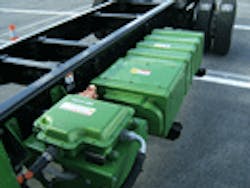Hybrids to rule the alternative power world by 2020
A new study by global research firm Frost & Sullivan indicates that hybrid propulsion technology is far and away going to be the leading alternative power choice in the world’s medium-heavy commercial truck and bus market by 2020.
Transit buses, in particular, will make up the lion’s share of hybrid fleets in terms of installation rates, while medium-heavy trucks featuring parallel hybrid architecture will account for the majority of the production volumes, noted Sandeep Kar, Frost & Sullivan’s global director-commercial vehicle research.
He explained in an interview with Fleet Owner that the reason for such near-term dominance by hybrid systems is that they place the least amount of demand on infrastructure while reducing petroleum consumption by heavy trucks and buses.
“There’s just no money available for the scale of infrastructure necessary for widespread use of all-electric vehicles or ones powered by compressed natural gas (CNG) and liquefied natural gas (LNG),”Kar pointed out. “That makes hybrid technology the easiest alternative powertrain for fleets to adopt.”
Frost & Sullivan’s study – entitled “Strategic Analysis of North and South American Medium-Heavy Duty Hybrid and Electric Truck/Bus Markets” – projects that some 307,000 hybrid and electric buses, medium and heavy trucks will be manufactured worldwide in 2020, up from just 6,934 in 2009, with North America home to nearly 50% of the global production and sales.
The firm also believes fully 59% of the transit buses in North America will be powered by hybrid-electric systems by 2020, with hybrids making up 15% of the heavy commercial vehicle (HCV) population.
By contrast, only 12% of transit buses will be all-electric, along with just 4% of HCVs. Only 7 to 8% of transit buses and HCVs will be powered by either CNG or LNG, Frost & Sullivan predicts.
“If you thought Europe will be the second largest market for hybrid and electric buses and trucks, think again,” Kar stressed. “China will emerge as the second biggest market outside the U.S. for hybrid and electric trucks and buses.”
Chinese OEMs and system suppliers are gradually moving up the learning curve and value chain and could arguably emerge as leading suppliers to the local OEMs that are showing interest in expanding hybrid/electric truck and bus offerings, Kar said.
“However, in the short-medium term, American suppliers such as Eaton Corp. and Allison Transmission among others will lead the global market in offering hybrid modules,” he stressed.
Kar added that three “mega-trends” will drive adoption of hybrid powertrains among bus and commercial truck fleets: increased urbanization, more traffic congestion and higher energy costs.
Yet he also stressed that hybrids “are not the solution for all fleets” and thus will only truly develop in certain niche markets such as short haul plus pickup-and-delivery style truck operations, alongside the transit buses.
Still, hybrids will be far more successful in the medium-heavy truck segment, whereas pure electrics will gain a foothold mainly in the light and medium end of the trucking spectrum, Kar said.
“Hybrids are good for specific applications where there is a tremendous amount of ‘stop and go’ activity, which is common in operations along congested city streets,” he explained. “There won’t be demand for hybrids in the long-haul segment where trucks operate at steady highway speeds. This will be the biggest impediment for large-scale penetration and production of hybrids in developed markets such as the U.S.”
Cost will also slow the growth of hybrids among bus and truck fleets to 2020, with private fleets more readily adopting hybrids compared to their for-hire brethren as private carriers have more money to invest, Kar added.
“Despite many incentives, hybrid powertrains remain considerably expensive,” he pointed out, especially where the batteries are concerned. “Every four or five years, fleets will need to change out the batteries in their hybrid trucks – that’s a roughly $10,000 expense per vehicle right there.”
But the biggest factor in what will determine the speed of hybrid powertrain adoption among bus and truck fleets over the next decade is what happens in terms of fuel prices.
“Our fleet focused research coupled with industry research reveals that most fleet managers want an ROI and payback within 4 to 4.5 years of purchasing these vehicles,” Kar noted. “With a rapid increase in diesel prices, the payback period can shorten significantly, and that – more than any incentive or tax-credit – will lead proactive fleet managers towards hybrids and pure-electrics.”
When the global economy really bounces back and demand for oil begins to increase from China and India, that’s when things could really change, he believes.
“When we start to move to $4.50 to $5 per gallon diesel, that’s when the gains in fuel efficiency hybrids offer really begin to narrow the price points compared to gasoline or diesel-only powered vehicles,” Kar said.
About the Author
Sean Kilcarr
Editor in Chief
Sean Kilcarr is a former longtime FleetOwner senior editor who wrote for the publication from 2000 to 2018. He served as editor-in-chief from 2017 to 2018.
